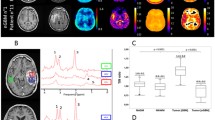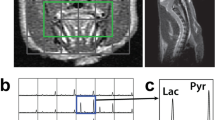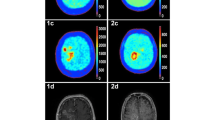Abstract
Object
In tumor cells the energy production is shifted from aerobic to anaerobic metabolization of glucose, which makes the cerebral metabolic rate of oxygen consumption (CMRO2) a diagnostic parameter for tissue viability. Direct oxygen-17 (17O) MRI during inhalation of 17O gas allows for a non-invasive determination of the CMRO2. However, the low spatial resolution and the fast transverse relaxation of 17O lead to partial volume effects that severely bias the quantification of signal intensities. The aim of this work was to determine the CMRO2 in a tumor patient by 17O MRI in combination with a partial volume correction (PVC) scheme.
Materials and methods
Direct 17O MRI was performed in a glioblastoma patient (F, 51 years) prior to surgery at 7 T. The ‘geometric transfer matrix’ algorithm for volume of interest based PVC was adapted to 17O MRI to recover the true signal intensities. We determined the CMRO2 values of gray matter (GM), white matter (WM), cerebrospinal fluid (CSF) and the tumor areas of the contrast enhancing rim (CE), the necrotic center (NE), and the perifocal edema (PE) using a three-phase metabolic model.
Results
Large differences in the signal increase during 17O2 inhalation were obtained ranging from less than 2 % in the tumor center up to more than 20 % in GM areas. After PVC of the signal time curves, we determined CMRO2 values of 0.67 ± 0.08 μmol/g/min (WM), 3.57 ± 0.67 μmol/g/min (GM), 0.35 ± 0.09 μmol/g/min (CE), and 0.42 ± 0.05 μmol/g/min (PE). In CSF and NE no oxygen uptake (i.e. CMRO2 = 0) was determined from the corrected signals, well in accordance with the underlying physiology in these regions.
Conclusion
The results show that PVC has a strong effect on the resulting CMRO2 values obtained by 17O MRI. We found substantial differences—especially in GM tissue—between corrected and non-corrected CMRO2 values. Additionally, we demonstrated the feasibility of CMRO2 assessment in a glioblastoma patient by 17O MRI.




Similar content being viewed by others

References
Fox PT, Raichle ME, Mintun MA, Dence C (1988) Nonoxidative glucose consumption during focal physiologic neural activity. Science 241(4864):462–464
Alberts B (2008) Molecular biology of the cell, 5th edn. Garland Science, New York
Miles KA, Williams RE (2008) Warburg revisited: imaging tumour blood flow and metabolism. Cancer Imaging 8:81–86
Vander Heiden MG, Cantley LC, Thompson CB (2009) Understanding the Warburg effect: the metabolic requirements of cell proliferation. Science 324(5930):1029–1033
Frackowiak RSJ, Lenzi GL, Jones T, Heather JD (1980) Quantitative measurement of regional cerebral blood-flow and oxygen-metabolism in man using O-15 and positron emission tomography—theory, procedure, and normal values. J Comput Assist Tomogr 4(6):727–736
Mintun MA, Raichle ME, Martin WR, Herscovitch P (1984) Brain oxygen utilization measured with O-15 radiotracers and positron emission tomography. J Nucl Med 25(2):177–187
Rhodes CG, Wise RJS, Gibbs JM, Frackowiak RSJ, Hatazawa J, Palmer AJ, Thomas DGT, Jones T (1983) Invivo disturbance of the oxidative-metabolism of glucose in human cerebral gliomas. Ann Neurol 14(6):614–626
Ito M, Lammertsma AA, Wise RJS, Bernardi S, Frackowiak RSJ, Heather JD, Mckenzie CG, Thomas DGT, Jones T (1982) Measurement of regional cerebral blood-flow and oxygen utilization in patients with cerebral-tumors using O-15 and positron emission tomography—analytical techniques and preliminary-results. Neuroradiology 23(2):63–74
Mineura K, Yasuda T, Kowada M, Shishido F, Ogawa T, Uemura K (1986) Positron emission tomographic evaluation of histological malignancy in gliomas using oxygen-15 and fluorine-18-fluorodeoxyglucose. Neurol Res 8(3):164–168
Tyler JL, Diksic M, Villemure JG, Evans AC, Meyer E, Yamamoto YL, Feindel W (1987) Metabolic and hemodynamic evaluation of gliomas using positron emission tomography. J Nucl Med 28(7):1123–1133
Fiat D, Hankiewicz J, Liu S, Trbovic S, Brint S (2004) 17O magnetic resonance imaging of the human brain. Neurol Res 26(8):803–808
Atkinson IC, Thulborn KR (2010) Feasibility of mapping the tissue mass corrected bioscale of cerebral metabolic rate of oxygen consumption using 17-oxygen and 23-sodium MR imaging in a human brain at 9.4 T. Neuroimage 51(2):723–733
Hoffmann SH, Begovatz P, Nagel AM, Umathum R, Schommer K, Bachert P, Bock M (2011) A measurement setup for direct 17O MRI at 7 T. Magn Reson Med 66(4):1109–1115
Nagel AM, Laun FB, Weber MA, Matthies C, Semmler W, Schad LR (2009) Sodium MRI using a density-adapted 3D radial acquisition technique. Magn Reson Med 62(6):1565–1573
Tiep B, Christopher K, Spofford B, Goodman J, Worley P, Macy S (1990) Pulsed nasal and transtracheal oxygen delivery. Chest 97(2):364–368
Jackson JI, Meyer CH, Nishimura DG, Macovski A (1991) Selection of a convolution function for Fourier inversion using gridding [computerised tomography application]. IEEE Trans Med Imaging 10(3):473–478
Smith SM, Jenkinson M, Woolrich MW, Beckmann CF, Behrens TE, Johansen-Berg H, Bannister PR, De Luca M, Drobnjak I, Flitney DE, Niazy RK, Saunders J, Vickers J, Zhang Y, De Stefano N, Brady JM, Matthews PM (2004) Advances in functional and structural MR image analysis and implementation as FSL. Neuroimage 23(Suppl 1):S208–S219
Woolrich MW, Jbabdi S, Patenaude B, Chappell M, Makni S, Behrens T, Beckmann C, Jenkinson M, Smith SM (2009) Bayesian analysis of neuroimaging data in FSL. Neuroimage 45(1 Suppl):S173–S186
Rousset OG, Ma YL, Evans AC (1998) Correction for partial volume effects in PET: principle and validation. J Nucl Med 39(5):904–911
Aston JA, Cunningham VJ, Asselin MC, Hammers A, Evans AC, Gunn RN (2002) Positron emission tomography partial volume correction: estimation and algorithms. J Cereb Blood Flow Metab 22(8):1019–1034
Frouin V, Comtat C, Reilhac A, Gregoire MC (2002) Correction of partial-volume effect for PET striatal imaging: fast implementation and study of robustness. J Nucl Med 43(12):1715–1726
Wang H, Fei B (2012) An MR image-guided, voxel-based partial volume correction method for PET images. Med Phys 39(1):179–195
Meltzer CC, Kinahan PE, Greer PJ, Nichols TE, Comtat C, Cantwell MN, Lin MP, Price JC (1999) Comparative evaluation of MR-based partial-volume correction schemes for PET. J Nucl Med 40(12):2053–2065
Tohka J, Reilhac A (2008) Deconvolution-based partial volume correction in raclopride-PET and Monte Carlo comparison to MR-based method. Neuroimage 39(4):1570–1584
Erlandsson K, Buvat I, Pretorius PH, Thomas BA, Hutton BF (2012) A review of partial volume correction techniques for emission tomography and their applications in neurology, cardiology and oncology. Phys Med Biol 57(21):R119–R159
Gurney PT, Hargreaves BA, Nishimura DG (2006) Design and analysis of a practical 3D cones trajectory. Magn Reson Med 55(3):575–582
Hoffmann SH, Nagel AM, Meise FM, Umathum R, Bock M (2011) In vivo relaxation parameters of oxygen-17 (17O). In: Proceedings of the 19th scientific meeting, international society for magnetic resonance in medicine, Montreal, p 473
Ganong WF (2001) Review of medical physiology, 20th edn. McGraw Hill, Stamford
Whittall KP, MacKay AL, Graeb DA, Nugent RA, Li DKB, Paty DW (1997) In vivo measurement of T-2 distributions and water contents in normal human brain. Magn Reson Med 37(1):34–43
Neeb H, Zilles K, Shah NJ (2006) A new method for fast quantitative mapping of absolute water content in vivo. Neuroimage 31(3):1156–1168
Wen PY, Kesari S (2008) Malignant gliomas in adults. N Engl J Med 359(5):492–507
Leenders KL, Perani D, Lammertsma AA, Heather JD, Buckingham P, Healy MJ, Gibbs JM, Wise RJ, Hatazawa J, Herold S, Beany RP, Brooks DJ, Spinks T, Rhodes C, Frackowiak RSJ, Jones T (1990) Cerebral blood flow, blood volume and oxygen utilization. Normal values and effect of age. Brain 113(Pt 1):27–47
Raichle ME, MacLeod AM, Snyder AZ, Powers WJ, Gusnard DA, Shulman GL (2001) A default mode of brain function. Proc Natl Acad Sci USA 98(2):676–682
Ibaraki M, Miura S, Shimosegawa E, Sugawara S, Mizuta T, Ishikawa A, Amano M (2008) Quantification of cerebral blood flow and oxygen metabolism with 3-dimensional PET and 15O: validation by comparison with 2-dimensional PET. J Nucl Med 49(1):50–59
Baumgardner JE, Mellon EA, Tailor DR, Mallikarjunarao K, Borthakur A, Reddy R (2008) Mechanical ventilator for delivery of 17O2 in brief pulses. Open Biomed Eng J 2:57–63
Spence AM, Muzi M, Swanson KR, O’Sullivan F, Rockhill JK, Rajendran JG, Adamsen TC, Link JM, Swanson PE, Yagle KJ, Rostomily RC, Silbergeld DL, Krohn KA (2008) Regional hypoxia in glioblastoma multiforme quantified with [18F]fluoromisonidazole positron emission tomography before radiotherapy: correlation with time to progression and survival. Clin Cancer Res 14(9):2623–2630
Brown JM, Wilson WR (2004) Exploiting tumour hypoxia in cancer treatment. Nat Rev Cancer 4:437–447
Acknowledgments
The authors thank Christine Gnahm, Dr. Reiner Umathum, and Dr. Klaus Maier-Hein for their assistance in the experiment and the data analysis and the Wilhelm Sander foundation for financial support of the project.
Author information
Authors and Affiliations
Corresponding author
Rights and permissions
About this article
Cite this article
Hoffmann, S.H., Radbruch, A., Bock, M. et al. Direct 17O MRI with partial volume correction: first experiences in a glioblastoma patient. Magn Reson Mater Phy 27, 579–587 (2014). https://doi.org/10.1007/s10334-014-0441-8
Received:
Revised:
Accepted:
Published:
Issue Date:
DOI: https://doi.org/10.1007/s10334-014-0441-8



